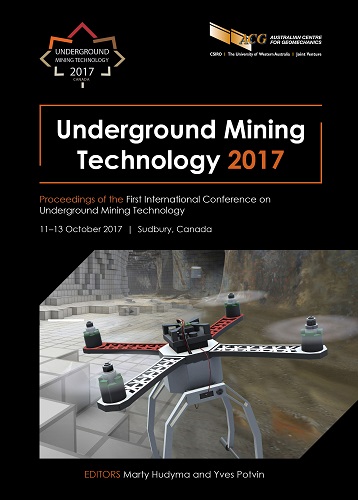Mining method optimisation of Bayi gold mine based on the value engineering principle

|
Authors: Cai, SJ; Lyu, WS; Wu, D; Yang, P |
DOI https://doi.org/10.36487/ACG_rep/1710_41_Cai
Cite As:
Cai, SJ, Lyu, WS, Wu, D & Yang, P 2017, 'Mining method optimisation of Bayi gold mine based on the value engineering principle', in M Hudyma & Y Potvin (eds), UMT 2017: Proceedings of the First International Conference on Underground Mining Technology, Australian Centre for Geomechanics, Perth, pp. 511-521, https://doi.org/10.36487/ACG_rep/1710_41_Cai
Abstract:
Bayi gold mine is located in the northeast of Habahe County, Altai city, Xinjiang autonomy region, China. There are No. 1 and No. 2 mining districts in the mine, of which No. 1 is the main production district. The group of 12# veins is the main orebody, of which the top veins over +610 m were mined out with the open pit mining method. The upper part of the remaining orebodies is mined underground with the shorthole shrinkage stoping method. However, at about +400 m level, those veins gradually merge into one 30–60m thick orebody, hence the mining method for the lower thick orebody has to be changed. For safe mining, the backfill method has been suggested. In this paper, mining method selection was regarded as a system engineering problem with multi-objective decision-making. In the primary selection, three kinds of underground backfill mining methods were proposed. A comprehensive multi-objective decision-making index system for mining method optimisation was built up based on the value engineering principle, and technical feasibility, resources utilisation and economic benefit factors were taken in consideration for safe mining and environmental protection. In order to integrate the experts’ experience and to put the original qualitative comparison into quantitative analysis, the comparative importance of the functional parameters decided by the 0–1 compulsory scoring method was introduced. Therefore, the functions and values of primary selected mining methods with unified multi-objective data for comparison were obtained. Based on that, the optimised mining method, i.e. sublevel open stoping with delayed backfill, was selected. The final optimised mining method was designed and put into stope preparation.
Keywords: mining method optimisation, value engineering principle, scheme comparison, sublevel open stoping with delayed backfill
References:
Bieniawski, ZT 1974, ‘Estimating the strength of rock materials’, Journal of South African Institute of Mining and Metallurgy, vol. 74, pp. 312–320.
Huang, WS, Cai, SJ, Wu, D, Huang, G & Liu, YC 2015, ‘Stability assessment of underground mined-out areas in a gold mine based on complex system theory’, Geotechnical and Geological Engineering, vol. 33, no. 5, pp. 1,295–1,305.
Ismail, A, Aminzadeh, R, Aram & A, Arshad, I 2010, ‘Using of value engineering in main road construction’, Journal of Applied Sciences, vol. 10, no. 22, pp. 2,950–2,953.
Liu, YC, Huang, WS, Cai, SJ, Liu, GX & Fan, JP 2015, ‘Numerical simulation study on analysis and controlling the subsidence of ground surface of the Bayi gold mine’, Gold, vol. 36, no. 5, pp. 39–42.
Tian, JB & Cai, P 2012, ‘Application of sublevel open mining with delayed backfill method in the Lilou iron mine’, Metal Mine, no. 6, pp. 19–25.
Wang, YM 2012, Modern Mining Handbook, Metallurgical Industry Press, Beijing.
Xu, ZY 2011, ‘Application of engineering economic principles in selecting mining method’, Metal Mine, no. 1, pp. 38–41.
Yu, RC 2009, Mining Engineer’s Handbook, Metallurgical Industry Press, Beijing.
Zhang, HQ 2009, ‘Application of value engineering design optimization’, Shanxi Architecture, no. 6, pp. 265–266.
Zheng, Y, Lu, XB & Cheng, Y 2010, ‘Geology and genesis of the Bayi gold deposit, Xinjiang’, Geological Science and Technology Information, vol. 29, no. 2, pp. 123–129.
© Copyright 2025, Australian Centre for Geomechanics (ACG), The University of Western Australia. All rights reserved.
View copyright/legal information
Please direct any queries or error reports to repository-acg@uwa.edu.au
View copyright/legal information
Please direct any queries or error reports to repository-acg@uwa.edu.au